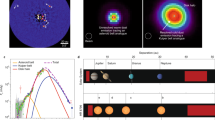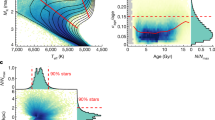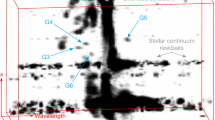Abstract
Almost 5 billion years ago, the Sun formed in a local contraction of a cloud of molecular gas. A rotating disk of gas and dust is believed to have fed material onto the proto-Sun for the first few million years of its life, and to have formed the planets, comets and other Solar System objects. Similar disks, but with less mass, have been observed around a few main-sequence stars such as Vega1. The dust particles orbiting stars like Vega will be removed on timescales of the order of 1 Myr (Vega is about 350 Myr old), and therefore must be resupplied1, at least for a time. But earlier surveys2,3 lacked the sensitivity to determine how many nearby stars have dust disks, and to investigate how long such disks survive. Here we report infrared observations indicating that most stars younger than 300 Myr have dust disks, while most older than 400 Myr do not: ninety per cent of the disks disappear when the star is between 300 and 400 Myr old. Several events that are related to the ‘clean up’ of debris in the early history of our Solar System have a similar timescale.
This is a preview of subscription content, access via your institution
Access options
Subscribe to this journal
Receive 51 print issues and online access
$199.00 per year
only $3.90 per issue
Buy this article
- Purchase on Springer Link
- Instant access to full article PDF
Prices may be subject to local taxes which are calculated during checkout

Similar content being viewed by others
References
Aumann,H. et al. Discovery of a shell around Alpha Lyrae. Astrophys. J. 278, L23–L27 ( 1984).
Backman,D. E. & Paresce,F. in Protostars and Planets III (eds Levy, E. H. & Lunine, J. I.) 1253–1304 (Univ. Arizona Press, Tucson, 1993).
Gaidos,E. J. Observational constraints on late heavy bombardment episodes around young solar analogs. Astrophys. J. 510, L131– L134 (1999).
Lemke,D. et al. ISOPHOT—capabilities and performance. Astron. Astrophys. 315, L64–L70 (1996).
Kessler,M. et al. The Infrared Space Observatory (ISO) mission. Astron. Astrophys. 315, L27–L31 (1996).
Plets,H. & Vynckier,C. An analysis of the incidence of the Vega phenomenon among main-sequence and post main-sequence stars. Astron. Astrophys. 343, 496–506 (1999).
Lachaume,R., Dominik,C., Lanz,T. & Habing,H. J. Age determinations of main-sequence stars: combining different methods. Astron. Astrophys. (in the press).
Ábrahám,P., Leinert,C., Burket,A., Lemke,D. & Henning,T. Search for cool circumstellar matter in the Ursae Majoris group with ISO. Astron. Astrophys. 338, 91–96 (1998).
Barrado y Navascues,D., Stauffer,J., Song,I. & Caillaut,J. The age of Beta Pic. Astrophys. J. (in the press).
Liseau,R. & Artymowicz,P. On the low gas-to-dust mass ratio of the circumstellar disk around β Pictoris. Astron. Astrophys. 334, 935–942 ( 1998).
Artymowicz,P. & Clampin,M. Dust around main-sequence stars: nature or nurture by the interstellar medium. Astrophys. J. 490, 863–878 (1997).
Lagrange, A.-M., Backman,D. & Artymowicz, P. Planetary material around main-sequence stars. In Protostars and Planets IV (eds Mannings, V., Boss, A. & Russell, S.) (Univ. Arizona Press, Tucson, in the press).
Dominik,C., Laureijs,R., Jourdain de Muizon, M. & Habing,H. J. A Vega-like disk associated with the planetary system ρ1 Cnc. Astron. Astrophys. 329, L53– L56 (1998).
Jourdain de Muizon,M., Laureijs,R. J., Dominik,C. & Habing,H. J. A very cold disc of dust around the G0V star HD 207129. Astron. Astrophys. (in the press).
Dohnanyi,J. Collisional model of asteroids and their debris. J. Geophys. Res. 74, 2531–2554 ( 1969).
Stern,S. A. & Colwell,J. E. Accretion in the Edgeworth-Kuiper belt: forming 100–1000 km radius bodies at 30 AU and beyond. Astron. J. 114, 841–849 (1997).
Stern,S. A. & Colwell,J. E. Collisional erosion in the primordial Edgeworth-Kuiper Belt and the generation of the 30–50 AU Kuiper Gap. Astrophys. J. 490, 879– 882 (1997).
Duncan,M. J., Levison,H. F. & Budd, S. M. The dynamical structure of the Kuiper Belt. Astron. J. 110, 3073–3081 (1995).
Weissman,P. in The New Solar System 4th edn (eds Beatty, J. K., Petersen, C. C. & Chaikin, A.) 59–68 (Sky Publishing Corp. and Cambridge Univ. Press, Cambridge, Massachusetts, 1999).
Butler,R., Marcy,G. W., Williams,E., Hauser,H. & Shirts,P. Three new 51 Pegasi-type planets. Astrophys. J. 474, L115–L118 ( 1997).
Trilling,D. & Brown,R. A circumstellar dust disk around a star with a known planetary companion. Nature 395, 775–777 (1998).
Henry,T., Soderblom,D., Donahue,R. & Baliunas,S. A survey of CaII H and K chromospheric emission in southern stars. Astron. J. 111, 439–465 (1996).
Acknowledgements
C.D. was supported by ASTRON, the Stichting Astronomisch Onderzoek Nederland.
Author information
Authors and Affiliations
Corresponding author
Rights and permissions
About this article
Cite this article
Habing, H., Dominik, C., Jourdain de Muizon, M. et al. Disappearance of stellar debris disks around main-sequence stars after 400 million years. Nature 401, 456–458 (1999). https://doi.org/10.1038/46749
Received:
Accepted:
Issue Date:
DOI: https://doi.org/10.1038/46749
This article is cited by
-
Vega is a rapidly rotating star
Nature (2006)
-
Debris Discs Around Stars: The 2004 ISO Legacy
Space Science Reviews (2005)
-
Substantial reservoirs of molecular hydrogen in the debris disks around young stars
Nature (2001)
Comments
By submitting a comment you agree to abide by our Terms and Community Guidelines. If you find something abusive or that does not comply with our terms or guidelines please flag it as inappropriate.



